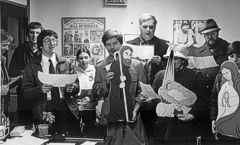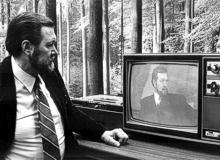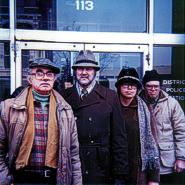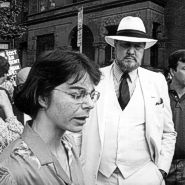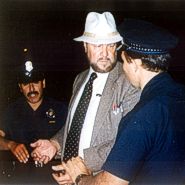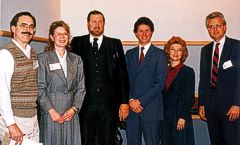NOTE: This is the first installment in a four-part Twenty-Fifth Anniversary retrospective series on the Pro-Life Action League.
Joe leads a protest in the driving rain at the now closed Park Medical Center abortion mill on Peterson Ave. in Chicago, June 13, 1981
This is a banner year for the Pro-Life Action League. We have been in the business of saving babies from abortion for twenty-five years.
Ann and I got involved in what was then called the “anti-abortion” movement the day after the Roe v. Wade decision came down. In fact we attended our first anti-abortion rally a few months before Roe v. Wade in October 1972.
Ann talked me into going to an Illinois Right to Life rally at the Civic Center, now called Daley Plaza, in downtown Chicago. It was a sunny Saturday afternoon. I had planned to spend the afternoon watching a Notre Dame football game on TV. Instead we went downtown with our three little boys, Eric, 6, Joe, 5 and Peter, 3.
Facing the Truth for the First Time
During the rally a volunteer handed me a “Life and Death” brochure and I saw for the first time the photo of a garbage bag full of late-term aborted babies. I thought the face of the little baby on the top of the pile looked like Eric’s baby picture. I was horrified.
But abortion wasn’t legal in Illinois, or in most of the other states. I didn’t yet feel an urgent need to get more involved. I had no idea that Roe v. Wade was wending its way through the judicial system. I had no idea we were on the verge of a national holocaust.
Roe v. Wade jolted me out of my complacency, and I began to look for a way to fight this injustice, some way to get involved. I went to the library and studied fetal development and learned about the different methods of abortion. I started going to pro-life meetings and spent long hours learning all about the abortion issue. I was dismayed by the indifference of the media, the complacency of my fellow citizens, the inaction of my fellow Christians.
Finally my boss at a public relations firm took me aside and told me he had noticed that all my attention was focused on abortion. Fortunately he was pro-life too. He suggested I might do well to turn all my energy to the abortion battle as a full-time vocation. He was right.
The Founding of the League
In March 1973 I started the Chicago Office for Pro-Life Publicity in an office in my basement. I worked to publicize the truth about fetal development, putting to use my experience in journalism and public relations. I thought once people knew that the unborn baby was a human being they would rise up against abortion. How naïve I was.
The Pro-Life Action League was founded upon the dedication exemplified by these waterlogged picketers at Park Medical Center, June 13, 1981
I had a lot to learn about what it would take to open up people’s hearts to the plight of unborn babies, and how much resistance there would be to the truth. I couldn’t even get newspapers to take ads that stated, “An unborn baby’s heart is beating at 21 days”!
I could see that a more direct, active approach was demanded. And that’s why after seven years working for three other pro-life organizations, I finally founded the Pro-Life Action League in 1980.
At first I was back to my basement office. Then I discovered a small storefront space just a block from my house. I called a meeting of about thirty deeply committed pro-life activists—people who were going out to picket abortion clinics, writing letters to the editor and feeling as frustrated as I was about the need for more direct action. From that meeting we put together a small staff—Barbara Menes as office manager and secretary, Marian Masella, librarian and keeper of the files, my son Joe as mailing manager. My attorney father-in-law took care of the incorporation procedure and the Pro-Life Action League was in business.
The League Goes National
I had launched my telephone Hotline on May 24, 1974 and brought it with me to the Pro-Life Action League so activists across the country had a constant connection to new developments in the pro-life movement.
The Pro-Life Action League quickly achieved national prominence. In March 1981 Chicago magazine ran an eight-page story on the League’s leadership in the suspension of abortions at Cook County Hospital. Author Al Lanier called the Pro-Life Action League office a “war camp” and quoted a member of NARAL (the National Abortion Rights Action League), “If you cannot admire the guy [Scheidler] for his views or style, you’ve got to give him credit for his perseverance.”
We began publishing the Action News as a monthly newsletter early in 1981, and the old issues are chock full of activities. The League launched national Days of Rescue in 1980—seven years before Operation Rescue came on the scene. Hundreds of activists all across the country protested abortion at clinics in their cities on an appointed day several times a year. When the second national day of rescue was announced many clinics closed for the day just to avoid the aggravation of having pickets in front of their centers.
Outside the League’s first office on LeMai Ave. in Chicago, from left: Jim Weber, Ann Scheidler, young Joe Scheidler, Barbara Menes, Joe, Marian Masella, Steven Bower and Rich Freeman
The League was featured in a CBS 60 Minutes segment in front of the Park Medical Center on Peterson Avenue in Chicago. Two hundred and fifty picketers showed up in a driving rain. That abortion mill closed for good in 1990.
In July of 1981 the League protested President Ronald Reagan’s appointment of Sandra Day O’Connor to the U. S. Supreme Court. Although her first vote on abortion was pro-life, her subsequent votes were not favorable. The League and their friends who objected to Reagan’s appointment of O’Connor turned out to be right.
Employing New Tactics
In the early days of the League’s fundraising, we tried all sorts of innovations. Our office building had a large yard next to it, so we held huge yard sales. The first one in 1980 netted $2000. We also auctioned off Twenty-Dollar gold pieces, which the winners would often donate back to the League for another auction. We bought out the entire Goodman Theatre for their November 26, 1980 production of A Christmas Carol. The theater crew did not seem thrilled with a full house of pro-lifers, but the performance was great and the pro-life audience loved it.
When advice columnist Ann Landers announced her pledge to take on the right-to-life movement and defeat the Human Life Amendment, the League announced a “dump Ann Landers” campaign. Apparently it was effective because she stopped writing about abortion and never again mentioned her crusade against pro-life.
The League sings Christmas Carols at the downtown Chicago offices of the pro-abortion anti-Christian ACLU
During Christmas 1981 we began a League tradition—Christmas caroling at the ACLU offices. And in January 1982, I made a New Year’s Resolution—”No More Mr. Nice Guy.” Art O’Brien of New Jersey had a shirt made bearing that motto.
Important Investigations
In 1982 we began to investigate the lawsuits filed against abortion clinics and doctors, laying the groundwork for what would become the Chicago Method of sidewalk counseling. That same year Planned Parenthood announced plans to open fifty new clinics in the Chicago metropolitan area. We held town hall meetings, and that never happened. In 2005 there are only seven.
In June 1982 the League again drew national media attention when we hired a private investigator to find an eleven-year-old girl who was being forced to have a late-term abortion. Dr. Jasper Williams, OB-Gyn., Pastor Hiram Crawford and counselor Laura Canning were able to speak with the girl’s mother. It was not clear whether the abortion ever took place.
Radical Nuns Target the League
When the Human Life Amendment was introduced in Congress a new, radical group of renegade nuns formed the National Coalition of American Nuns to fight the amendment. The League petitioned the Holy Father to discipline the nuns, including two from Chicago, Sr. Margaret Traxler and Sr. Donna Quinn, both of whom later picketed the League offices on the anniversary of Roe v. Wade. People magazine ran a story on the nuns’ project, quoting Scheidler that the nuns were deceitful and hypocritical to stay in the Catholic Church while undermining its teachings.
At the LeMai office, Joe reviews a local Chicago television news interview
I was interviewed by Ted Koppel on July 17, 1982 for his ABC Nightline show on the topic of the growing violence at abortion clinics and the attempts to implicate pro- lifers in these actions. Also on the program was Susan Hill, the administrator of a chain of a dozen abortion clinics. There had been no proof that any offense at an abortion clinic had been committed by anyone from a pro-life organization. However, the few incidents of vandalism fueled the pro-abortion groups and their allies in the media in their efforts to label all pro-lifers as violent.
The “Chicago Four” appear in court, from left: Greg Morrow, Joe, Andy Scholberg and Gerry McCarthy
First Pro-Life Arrest
My first pro-life arrest came on January 29, 1983, when twelve squad cars converged on Concord abortion clinic on Grand Avenue in Chicago (which closed in 2003). Greg Morrow, Andy Scholberg, Gerry McCarthy and I were handcuffed and put in a paddy wagon for an offense the police couldn’t specify. They finally decided it was either “mob action” or “inciting to riot.” We were simply picketing the abortion mill, which, of course, the clinic staff didn’t like, so they called the police and made specious claims about our activities. “The Chicago Four” were found not guilty when the case finally came to trial on April 20, 1983.
Having been arrested together, Andy Scholberg and I began a custom of infiltrating the National Abortion Federation annual conventions. Until we became too readily identified, we were able to sit in on their meetings and hear first-hand their own concerns about how working in abortion clinics affected their staff, their high turnover rate, and what to do about anti-abortion protests. We attended abortion conventions in New Orleans, Chicago, Boston, Los Angeles and other cities.
The League’s storefront office was vandalized a couple of times in early 1984, so the landlord refused to renew our lease. We needed more space anyway because the League was outgrowing that office. In June 1984 we moved into our current office building on Cicero Ave.
Activism Comes of Age
In May 1984, Jean Emond organized the first national pro-life activists convention in Ft. Lauderdale, FL. At that meeting, we agreed to meet annually and planned to picket the Kansas City Planned Parenthood clinic during the National Right to Life Committee annual convention in Kansas City, MO the next month. All the abortion clinics in Kansas City shut down to avoid confronting possible pro-life pickets. The power of activism was beginning to be felt.
Joe with Monica Migliorino Miller (left) and other activists in Washington, D.C. for the National Right to Life Convention, June 22, 1985 [Photo by Howard Deever]
My book on pro-life activism, CLOSED: 99 Ways To Stop Abortion, was released in January 1985 and the League was also featured in Newsweek magazine on the alleged campaign of pro-life activists to shut down the nation’s abortion clinics.
The second activists conference was held in Appleton, WI in April 1985, hosted by Jerry Horn and Pastor Norm Stone, who owned a motel in Appleton. The hotel marquis read: “Welcome Pro-Lifers—Have a Blast.” That sign became a major exhibit in the NOW v. Scheidler trial years later, with the pro-aborts claiming that “Have a Blast” was a reference to bombing abortion clinics! A dozen conference attendees sported name tags with a tiny fire-cracker attached. These too were used in the trial to depict the pro-lifers as violent.
Our reputation on the activist front was spreading beyond the United States. In August 1985 I was invited to address pro-life groups in Australia and New Zealand, where pro-lifers were working hard to get the government to enforce the laws against abortion.
The Pro-Life Action League spearheaded the Nuremberg Trials II—a simulated trial of the abortion providers for crimes against humanity, held in Nuremberg, PA in October 1985. Earl Appleby, Marcelle Richards and attorney John Jacubczyk served as the “judges” and found the abortionists “guilty.” The Nuremberg Trial received extensive publicity and was featured, along with the Appleton activist conference, in a pro-abortion film, “Holy Terror,” which was designed to poke fun at pro-lifers, but actually credited us with sophisticated organizational skills.
1986: A Difficult Year
At the League’s sixth annual Awards Brunch, April 27, 1986, our dedicated secretary Barbara Menes collapsed just after presenting Ann with a bouquet of red roses. Doctors and nurses in the audience rushed to her aid, administering CPR until the paramedics arrived, while the entire room prayed for her recovery. Two weeks later Barbara died from cardiac complications. Barbara had been the League’s living “computer” for six years. She personally typed every thank you letter and kept all the League’s records by hand. Her loss was devastating, but we had no choice but to move forward.
Joe is arrested in Denver on June 11, 1986 for entering an abortion clinic during a picket in Pensacola, FL earlier that year
The year 1986 was to be a difficult one. On June 11, while checking into the Denver Marriott City Center Hotel for the National Right to Life Convention, I was arrested in connection with a picket in Pensacola, FL and spent the next sixteen hours in jail. I conducted nineteen media interviews from the jail.
I was released only to discover that the National Organization for Women (NOW) had filed a federal anti-trust lawsuit against me, accusing me of conspiring to drive abortion clinics out of business. I don’t know about “conspiracy,” but the goal sounded good to me. We didn’t pay much attention to the NOW v. Scheidler suit at first—we just went ahead with our pro-life work.
The pro-life activists convened in St. Louis for their annual activist convention and settled on the name Pro-Life Action Network (PLAN) for the coalition. Randall Terry showed up for the first time at that convention and was there mainly as an entertainer. Randy was a terrific jazz pianist. It was at that convention that he introduced his concept of large demonstrations with massive arrests, and coined the term Operation Rescue.
Pro-lifers like John Ryan, Monica Migliorino and Joan Andrews had been doing sit-ins inside of and in front of abortion clinics for several years and had begun to refer to these activities as “rescues,” but Terry popularized the idea and gained national attention when he rallied the Evangelical community to participate in the demonstrations.
Meet the Abortion Providers
In November 1987 we held the first-ever Meet the Abortion Providers Conference, featuring abortion providers who had converted to pro-life. The idea for the conference came to me while listening to a tape of Carol Everett’s presentation at the National Right to Life Convention, which I had missed thanks to my detour to jail.
I thought a conference where we could learn from the abortionists themselves just what led them to perform abortions, what made them quit and what we could do to be more effective would be a real eye-opener. In fact, I took some criticism from pro-lifers who felt that we did not owe a forum to those people who were guilty of having killed thousands of unborn babies. Some refused to attend the conference because they believed nothing worthwhile could be learned from a former abortion provider and that we were somehow honoring their role as abortionists by featuring them at a pro-life conference.
At the first Meet the Abortion Providers conference, from left: Chris Slattery, Adele Nathanson, Joe, Dr. Anthony Levatino, Carol Everett and Dr. Joe Randall
The conference was captivating. We learned things we could never have learned except from those who worked right in the abortion clinics. We discovered how deeply abortion affects the doctors who perform them and how effectively they shut down their emotions in order to provide what they convince themselves is a “service to women.”
A pilot from Hell, MI, Roger MacZura, whose avocation was video production, had called to ask if we would allow him to videotape the Abortion Providers conference. I said “Sure, just so you don’t get in the way.” That video was Providence in action. The testimonies from the first conference, with those in subsequent conferences, resulted in our “Meet the Abortion Providers” video.
The PLAN “Conspiracy”
The League was hit with a second lawsuit in July 1987 when abortionist Jan Barton sued, looking for an injunction against the League to get us to stop picketing and sidewalk counseling outside his American Women’s Medical Center in Chicago.
The League hosted the fourth annual PLAN Convention in Chicago in August 1987. This coalition of pro-life activists met annually to share expertise and to coordinate activities for the coming year. It was hosted each year by a different pro-lifer, in a different city.
PLAN had no headquarters, no officers, no permanent members, no bank account and no fundraising activities. Yet PLAN was cited by the National Organization for Women in their federal lawsuit against me and the League as the “entity” through which we all “conspired” and “extorted.” The annual PLAN meetings turned up as major exhibits in the League’s 1998 RICO trial in Chicago.
In the coming years, that case would assume greater and greater importance, as the abortionists worked to shut us down. And yet, we continued to fight for unborn babies’ lives and refine our methods—especially in the crucial area of sidewalk counseling.
Next Issue: “Pro-Life Action at the Foot of the Cross: The Spread of Sidewalk Counseling, 1988-1998”



